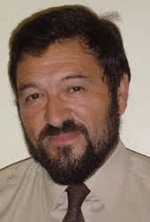Injectivity formation damage due to fines migration
Larissa Chequer A C , Mohammad Bagheri B , Abbas Zeinijahromi A and Pavel Bedrikovetsky AA Australian School of Petroleum, University of Adelaide, Adelaide, SA 5005, Australia.
B CO2CRC Limited, 11–15 Argyle Place, South Carlton, Melbourne, Vic. 3053, Australia.
C Corresponding author. Email: larissa.boechatchequer@adelaide.edu.au
The APPEA Journal 58(2) 700-704 https://doi.org/10.1071/AJ17191
Accepted: 5 March 2018 Published: 28 May 2018
Abstract
Formation damage by fines migration during low-salinity water injection can greatly affect field-scale waterflooding projects. In this paper, we present the basic governing equations for single-phase flow with detachment, migration and straining of natural reservoir fines. We perform laboratory corefloods with low-salinity water injections and monitor the breakthrough particle concentration and pressure drop across the core. The analytical model for linear flow matches the laboratory data with high accuracy. The analytical model for radial flow predicts well behaviour from laboratory-tuned coefficients. The calculations show that fines migration during low-salinity water injection causes significant injectivity decline. For typical values of fines-migration model coefficients, injectivity index declines 2–8 times during 10−3 pore volumes injected and the radius of the damaged zone does not exceed a few metres. We present two field cases on waterflooding and low-salinity water injection. The radial model presents good agreement with well injectivity field data.
Keywords: formation damage, linear flow, low-salinity waterflooding, radial model.

Larissa Chequer is a PhD student in Petroleum Engineering at the University of Adelaide, Australian School of Petroleum, Australia. She holds an MSc in Reservoir Engineering and a BEng in Exploration and Production Petroleum Engineering at the North Fluminense State University, Rio de Janeiro, Brazil. She is currently working with mathematical and laboratory modelling of suspension flow in porous media, low-salinity waterflooding, formation damage, injectivity impairment and fines migration. |

Mohammad Bagheri holds a PhD in Petroleum Engineering from the Sharif University of Technology in Tehran. For the past 15 years he has been working as a reservoir engineer in the oil and gas industry with NIOC, SPT group, BG group, the Victorian Government and Santos. He is now working as a Lead reservoir engineer with CO2CRC Ltd. in Melbourne. |

Dr Abbas Zeinijahromi is Senior Lecturer in Petroleum Engineering at the Australian School of Petroleum, University of Adelaide, where he specialises in formation damage and enhanced oil recovery. His current research interest is on low-salinity water injection including wettability alternation and fines migration. He is the author of over 35 articles in SPE and peer-reviewed scientific and engineering journals and served in various SPE committees. Abbas holds a PhD in Petroleum Engineering from the University of Adelaide, MSc in Reservoir Engineering and BSc in Production Engineering. |

Dr Pavel Bedrikovetsky is a Professor at the University of Adelaide. After defending his PhD at the Applied Mathematics Department of Moscow Gubkin Petroleum University in 1982, Pavel worked at the Oil-Gas Fluid Mechanics Department of this university until 1991, holding the position of Research Professor (DSc) in Petroleum Engineering. During 1991–1994 Pavel was a Visiting Professor at Delft University of Technology and at Imperial College of Science and Technology, where he wrote a book (Kluwer Academic, London, 1993) and consulted BP, British Gas, Chevron, Total, Shell and Statoil on enhanced oil recovery (EOR) and reservoir characterisation. In 1994 he became a Senior Staff Consultant to Petrobras in formation damage, waterflooding and IOR. Pavel joined ASP at the University of Adelaide in 2007 and works on nano-technologies, EOR and formation damage in close co-operation with Santos and with European oil companies. |
References
Akhmetgareev, V., and Khisamov, R. (2015). 40 Years of low-salinity waterflooding in Pervomaiskoye Field, Russia. In ‘Incremental Oil, SPE European Formation Damage Conference and Exhibition.’ (Society of Petroleum Engineers.)Barkman, J., Abrams, A., Darley, H., and Hill, H. (1975). An oil-coating process to stabilize clays in fresh waterflooding operations. Journal of Petroleum Technology 27, 1053–1059.
| An oil-coating process to stabilize clays in fresh waterflooding operations.Crossref | GoogleScholarGoogle Scholar |
Bedrikovetsky, P., Siqueira, F. D., Furtado, C. A., and Souza, A. L. S. (2011). Modified particle detachment model for colloidal transport in porous media. Transport in Porous Media 86, 353–383.
| Modified particle detachment model for colloidal transport in porous media.Crossref | GoogleScholarGoogle Scholar |
Civan, F. (2014). ‘Reservoir Formation Damage.’ (Gulf Professional Publishing: Burlington.)
Khilar, K. C., and Fogler, H. S. (1998). ‘Migrations of Fines in Porous Media.’ (Kluwer Academic Publishers: Dordrecht.)
Lake, L. W. (2010). ‘Enhanced Oil Recovery.’ (Society of Petroleum Engineers: Richardson.)
Nunes, M., Bedrikovetsky, P., Newbery, B., Paiva, R., Furtado, C., and De Souza, A. (2010). Theoretical definition of formation damage zone with applications to well stimulation. Journal of Energy Resources Technology 132, 033101.
| Theoretical definition of formation damage zone with applications to well stimulation.Crossref | GoogleScholarGoogle Scholar |
Oliveira, M. A., Vaz, A. S., Siqueira, F. D., Yang, Y., You, Z., and Bedrikovetsky, P. (2014). Slow migration of mobilised fines during flow in reservoir rocks: laboratory study. Journal of Petroleum Science Engineering 122, 534–541.
| Slow migration of mobilised fines during flow in reservoir rocks: laboratory study.Crossref | GoogleScholarGoogle Scholar |
Zeinijahromi, A., Vaz, A., and Bedrikovetsky, P. (2012). Well impairment by fines migration in gas fields. Journal of Petroleum Science Engineering 88–89, 125–135.
| Well impairment by fines migration in gas fields.Crossref | GoogleScholarGoogle Scholar |


